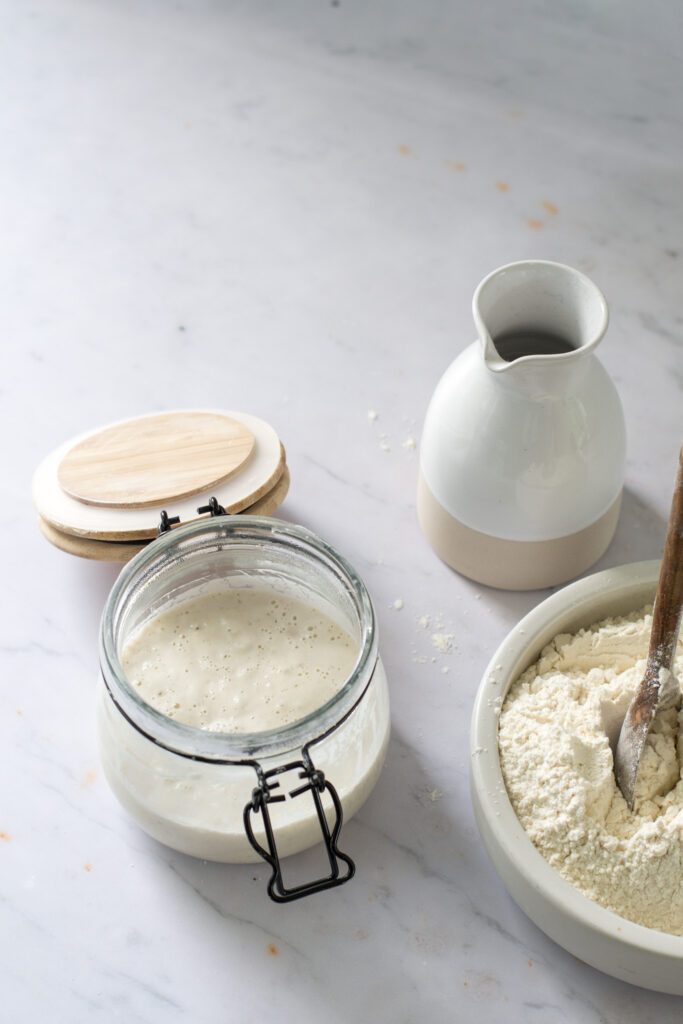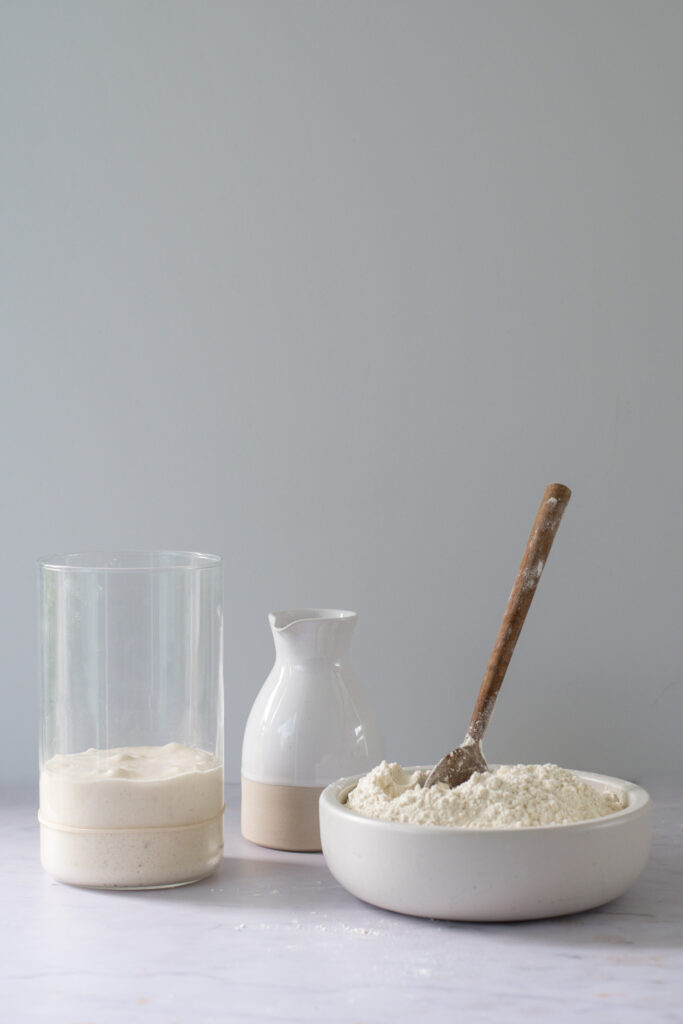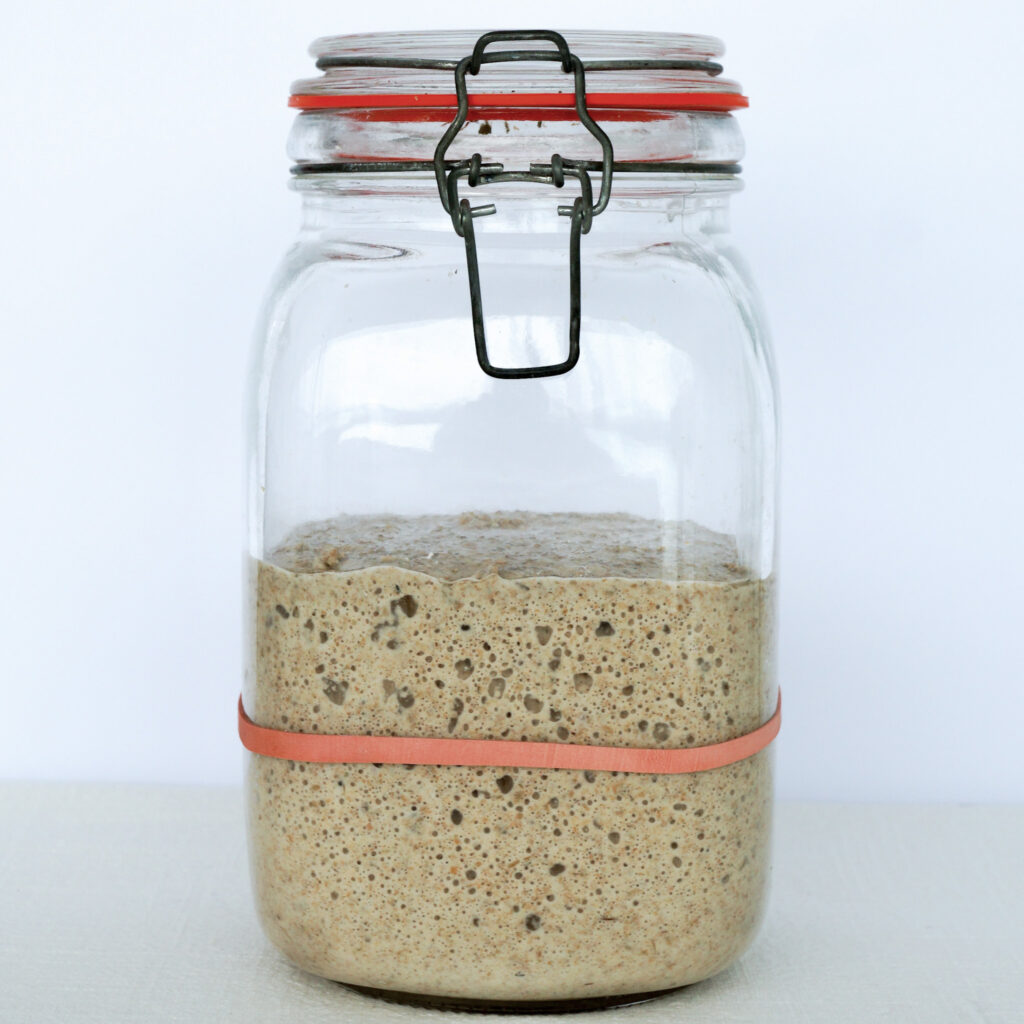
Making a sourdough starter is not at all complicated, it just takes a little time and patience.

Below you can find a step-by-step guide on how to make a sourdough starter. In general I use a dark rye starter for my everyday bread, I really like the flavour however I do always have a white starter on the go. I use this for pizza, focaccia and ciabatta.
* It’s worth noting that a wholegrain starter or a combination of wholegrains and white flour will take less time to mature because the microbes have more nutrients to feed from than with just white flour.
How to make a sourdough starter
Equipment
- 1 glass jar or plastic tub
Ingredients
- 50 g strong white or dark rye or equal quantities of white and wholemeal flour
- 50 g water room temperature
Instructions
DAY 1: MAKING THE STARTER
- Combine the flour and water in a large jar.
- Mix with a spoon until smooth; the consistency will be thick and pasty. Cover loosely with a tea towel and leave it in a warm place, about 23°C-24°C, for 24 hours.
DAY 2: ANY BUBBLES?
- Today check your starter to see if any small bubbles have appeared on the surface.
- Bubbles indicate activity and fermentation, this is what you want!
- It’s okay if you don’t see anything; the bubbles might have appeared and dissolved overnight.
- You don’t have to do anything else at the moment. Rest the starter in your warm place for another 24 hours.
DAY 3: FEED YOUR STARTER
- Whether bubbles are visible or not, it’s time to start the feeding process.
- To begin, remove and discard approximately half of your starter from the jar. The texture will be very stretchy. (if it's a white flour starter)
- Add 50g flour or equal quantities of the white and wholemeal and 50g of water. Mix with a spoon until smooth. The texture should resemble a thick-ish batter. (thicker if you're using just rye flour).
- Cover loosely, and let sit in your warm place for another 24 hours.
DAYS 4, 5, & 6: KEEP FEEDING
- Repeat the feeding process outlined on Day 3: Remove and discard half of the starter, and feed it with 50g flour and 50g of water.
- As the wild yeast begins to develop, your starter will rise, bubbles will form on the surface and throughout the culture.
- When the starter falls, it’s time to feed it again.
DAY 7: NOW YOU HAVE A SOURDOUGH STARTER
- By now, your sourdough starter should have doubled in size.
- You should see plenty of bubbles, both large and small. The texture will be spongy and fluffy. It should also smell pleasant, fruity and slightly alcoholic.
- If these conditions are met, your starter is now active and ready to use!
- Please bare in mind, if your starter is not ready at this point, which is quite common (the room temperature might be too cool and the wild yeast might need more time to grow etc.), continue to feed it for one to two weeks or more. A little patient is needed as everyones environment is different.
- As long as your starter is bubbly and it has doubled in size, you’re ready to go.
Q and A
Q – My starter has a dark brown liquid on the surface, is that okay?
A – Yes that’s fine, this is called the ‘hooch’ and it’s absolutely normal, just stir it into the starter.
Q – Where should I store my starter when it’s ready?
A – Store your starter in the fridge, feed once or twice in a week to keep it active. This is called a maintenance starter or ‘mother’. From this you can make a leaven. Always have approximately 200g of starter on the go. When you’re ready to feed, discard half and then mix in 50g each of flour and water. Mark with an elastic band or a pen. When the starter has risen a little past the line, pop it in the fridge. It will continue to rise in the cooler environment.
Q – It seems wasteful to discard starter or can I use it?
A – Yes you can, you can make all manner of things. Pancakes, waffles, brownies and knäckebröd (Swedish crispbread). The possibilities are endless.
Q – What is a leaven?
A – Essentially a leaven is the same as a starter. When you wish to bake, take a tablespoon (25g) of your active maintenance starter (that’s been fed in the last 2 days) place in a bowl or jar and mix in 100g each of flour and water. Cover and wait for it to double in size now it’s ready to bake with (or when it has grown by a third, put it in the fridge, it will be ready to bake with at your convenience the next day). This will make 225g leaven, enough for 2 rustic white loaves.
Q – What does it mean when a recipe calls for a starter with 100% hydration?
A – This means you starter should be fed with equal quantities of flour and water.






 Sea Bass, Lemon Roasted New Potatoes & Fennel
Sea Bass, Lemon Roasted New Potatoes & Fennel
What makes this sourdough?
A starter is just a combination of water and flour which then ferments and collects a bacteria called lactobacilli from the atmosphere. This is called wild yeast.
Hi, I love following all your baking. I have a quick question, to make a rye starter, can you take part of your regular starter and do the feeding with rye flour instead of the strong white flour? Thanks, Patty
Hi Patty,
Great to hear! Yes absolutely you can take a portion of your white starter to make a rye starter.